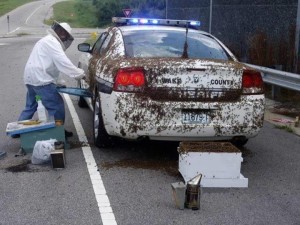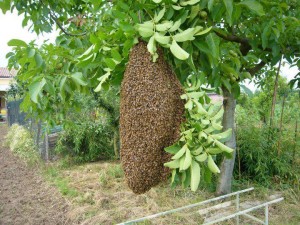Honey Bee swarms are a natural biological event. Although swarms normally occur during the spring months of April and May in Texas, they could happen in other months as well. Beekeepers do their best to prevent their own colonies from swarming throughout the year. A few steps we take include:
- Providing appropriate capacity (deeps/supers) relative to colony size
- Re-queening hives with older, less productive queens – especially in year 2
- Watching for swarm indicators like swarm cells within the hive
- Replacing 20-30% of old comb with fresh comb or foundation every 2-3 years on a rotational basis.
Feral bees will swarm under similar biological conditions that exist for beekeepers. These unmanaged populations may tend to issue swarms more often. When a “tree cavity” has become over-crowded, the colony can issue a swarm. If the colony conditions become unhealthy, the colony can issue a swarm


Conditions that include abundant nectar and pollen become “trigger” points for colonies to swarm as a natural means of ensuring continuation and growth of the species. Swarms issue after the queen has laid an egg; the colony has fed that egg in such a way that a queen cell develops (a swarm cell); a short time before the new queen cell hatches about one-third to two-thirds of the colony swarms out of the hive and normally congregates on a tree or other object approximately 30-40 yards from the originating colony. The massive “bunch of bees” at this point ensures that the original queen has made the flight and is within the swarm population. Scouts now begin identifying new locations for the swarm to reside and build a new hive.
After negotiations within the swarm and scouts, a location is selected and all the bees relocate to the new location. The swarm will generally only stay in on its initial swarm point for one to three days while the scouts are identifying potential new locations.
Swarms are generally not aggressive. They do not have brood (eggs/larva) or food resources to defend. Public concern over locations of swarm points (personal residences, schools, day care centers, senior centers, etc) are understandable and therefore we have provided the following map and contact information of swarm removal service providers that have registered with the Texas Apiary Inspection Service.
Each location point represents a County within the state where service providers have registered. Simply identify a map point close to the location of honey bees requiring removal, click on the map point for service provider contact information.
A number of beekeepers operate in 15 or more counties in the state of Texas. Please reach out to them directly to determine if they operate in your specific county.


2 thoughts on “Swarms”